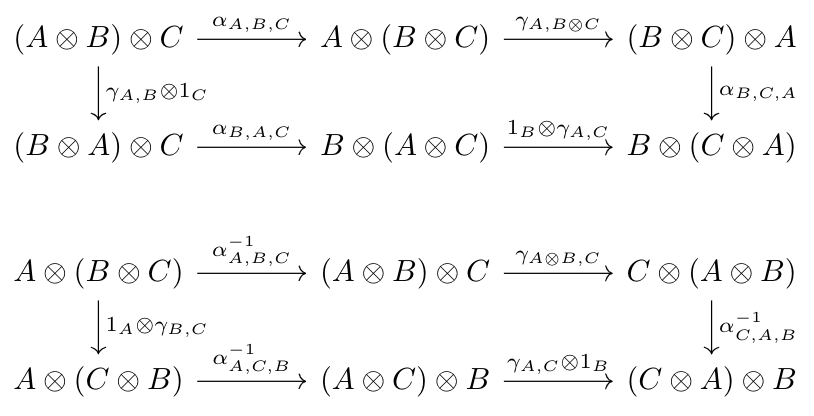Representation Stability and Finite Orthogonal Groups
Abstract:
We study an analogue of SI-modules where we consider finite orthogonal groups instead of symplectic groups over finite rings, and we proved basic Noetherianity properties of these new modules. In the future, we hope to use the property to prove homological stability theorems for orthogonal groups over finite rings.Bibliography/Citations:
- G Ganske and BR McDonald. “Finite local rings”. In:The Rocky Mountain Journal of Mathematics(1973), pp. 521–540.
- David Glasser. Classification of bilinear forms over finite fields. http://www-math.mit.edu/~dav/Fqquadforms.pdf. [Online lecture note; accessed February 15, 2021]. 2005.
- T.Y. Lam. A First Course in Noncommutative Rings. Graduate Texts in Mathematics. Springer, 2001. isbn: 9780387951836.
- Jeremy Miller and Jennifer CH Wilson. “Quantitative representation stability over linear groups”. In:International Mathematics Research Notices 2020.22 (2020), pp. 8624–8672.
- John Willard Milnor and Dale Husemoller. Symmetric bilinear forms. Vol. 73. Springer, 1973.
- Andrew Putman and Steven V Sam. “Representation stability and finite linear groups”. In:Duke Mathematical Journal 166.13 (2017), 2521–2598. issn: 0012-7094.
Additional Project Information
Research Plan:
1. Literature review
We review related work done by other mathematicians. Our main reference is [6] “Representation stability and finite linear groups”, in which previous work for general linear groups and symplectic groups was described. I will pay special attention to the section devoted to proving the results for the symplectic case, because orthogonal groups and symplectic groups share a lot of important properties, and much of our work will be based on the machinery established there.
To understand some parts of the literature, I will also need to read some standard textbooks on representation theory, category theory, and homological algebra.
2. Active research
After I finish learning prerequisite knowledge and reading the literature, I will try to generalize previous techniques and results to the new case we are dealing with, namely orthogonal groups. Because this research is a part of the PRIMES-USA program, I also have weekly research discussion meetings with my research mentor, who is a graduate student at MIT.
Questions and Answers
1. What was the major objective of your project and what was your plan to achieve it?
My major objective is to prove the local Noetherianity theorem for the category of OrI-modules, as analogous to already-established theorems on FI- and SI- modules.
a. Was that goal the result of any specific situation, experience, or problem you encountered?
Orthogonal groups are a family of groups that arise in a similar way as symplectic groups, so it is natural to generalize results on symplectic groups to the (more complicated) case on orthogonal groups.
b. Were you trying to solve a problem, answer a question, or test a hypothesis?
I was trying to solve the said problem and answer the question of whether further representation stability results involving symplectic groups also hold for the orthogonal groups.
2. What were the major tasks you had to perform in order to complete your project?
The main tasks (and the main difficulties) were 1) understanding the problem and related background knowledge, and 2) finding ways to approach a difficult question.
a. For teams, describe what each member worked on.
3. What is new or novel about your project?
a. Is there some aspect of your project's objective, or how you achieved it that you haven't done before?
Yes. I proved new results to a class of groups that have not been studied in the related context before.
b. Is your project's objective, or the way you implemented it, different from anything you have seen?
We used some new techniques in the course of our proof.
c. If you believe your work to be unique in some way, what research have you done to confirm that it is?
I have looked at past papers and research done on this topic, and I can confirm that nothing similar had been done in the past.
4. What was the most challenging part of completing your project?
a. What problems did you encounter, and how did you overcome them?
The biggest problem I encountered was that the problem involves fairly abstract concepts and is hard to approach. I overcame these problems by closely following past research done on this topic and trying to understand their thought process.
b. What did you learn from overcoming these problems?
I learned that it is often helpful to learn from what others had already successfully done.
5. If you were going to do this project again, are there any things you would you do differently the next time?
I would start earlier in doing the background reading. I feel that more reading and background knowledge is often very helpful as it offers many paths in attacking a particular problem.
6. Did working on this project give you any ideas for other projects?
I am not currently working on any other project.
7. How did COVID-19 affect the completion of your project?
The COVID-19 pandemic did not have a large impact on my project, since mathematics projects do not usually involve real-life experiments, etc.

